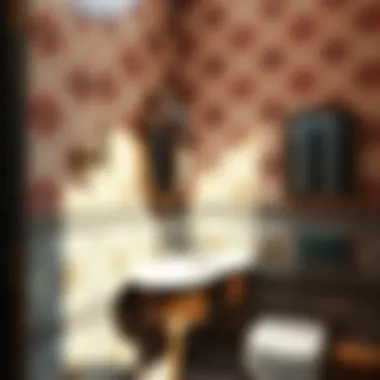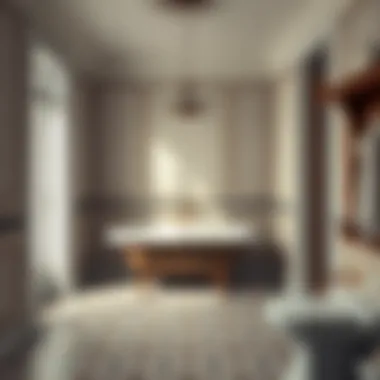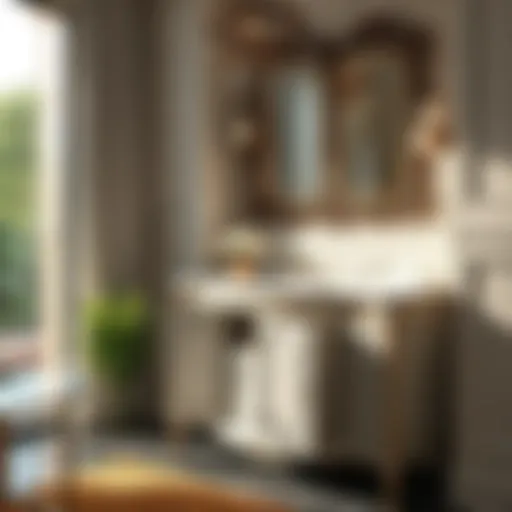Victorian Style Tiles for Timeless Bathroom Design


Intro
In the realm of home design, the choice of materials can remarkably shape the very soul of a space. One style that stands out is the Victorian flair, particularly when utilized through tiles. Victorian tiles in bathrooms serve not only as a nod to history but also as a canvas showcasing artistry that transcends mere functionality. This section sets the stage to explore the multifaceted beauty of these tiles, examining their historical significance and the enduring appeal they hold in today’s contemporary bathrooms.
The Victorian era, marked by its rich design and art styles, brought forth intricate patterns and vivid colours that can transform any mundane bathroom into an oasis of elegance. The use of tiles wasn't merely practical; it was a declaration of one’s taste and style. As one dives into the historical context and aesthetic allure of these tiles, it becomes apparent how they can accentuate a bathroom’s atmosphere, cultivating a vintage charm that resonates with both nostalgia and modernity.
Finding the right balance between tradition and contemporary tastes can be daunting, but the versatility of Victorian style tiles offers numerous possibilities. Whether you desire an authentic Victorian renovation or a more modern interpretation, this guide will provide comprehensive insights into integrating these enticing designs seamlessly into your space.
Historical Context of Victorian Style Tiles
Understanding the historical context of Victorian style tiles is like peeking through a window into a past era, revealing the intricate tapestry of culture, art, and social norms that shaped this distinctive design. The Victorian period, spanning from the early 1830s to the turn of the 20th century, was a time of significant change, marked by the industrial revolution and a surge in creativity. Tiles from this era reflect not just the aesthetic preferences of the time but also the technological advancements that made their production more accessible.
Victorian tiles are notable not just for their beauty, but also for their functionality in the bathroom—areas where cleanliness and practicality were paramount. As households began to incorporate indoor plumbing, the bathroom transformed from a rustic necessity into a space worthy of design consideration. This shift heralded a new appreciation for decor, and Victorian tiles became a symbol of sophistication and hygiene, turning bathrooms into places of refuge.
Origins of Victorian Tile Design
The roots of Victorian tile design are steeped in the advancements of the industrial revolution. The introduction of mass production techniques and pyrotechnology allowed for tiles to be produced at a scale unprecedented in history. This era saw the rise of local manufacturers alongside innovators.
One particular innovation was the use of encaustic tiles, which became widely favored for their durability and intricate designs. The process involved embedding colored clay into the tiles, allowing various patterns and motifs to become a permanent part of the tile. In addition, companies such as Minton and Doulton led the way in tile design, creating collections that featured vibrant colors, geometric patterns, and decorative scenes, thus influencing what we recognize as Victorian style tiles today.
Cultural Influences in Victorian Aesthetics
Culture during the Victorian period was rich and multifaceted, influenced by literature, the arts, and overseas explorations. The fascination with nature, historical motifs, and exotic patterns mirrored broader Victorian aesthetics. Many tiles incorporated designs inspired by medieval art, Renaissance influences, and even Middle Eastern geometrical patterns, demonstrating a blend of local craftsmanship with wider cultural currents.
Furthermore, the Arts and Crafts movement, which emerged towards the latter part of the Victorian era, emphasized handmade quality and a return to natural materials. This dovetailed with tile design, where artisans began to explore more organic themes focusing on flora and fauna motifs, which can be seen in tiles that feature stylized leaves or blossoms.
In sum, the historical context of Victorian style tiles not only highlights their aesthetic appeal but also illustrates how social, technological, and cultural shifts converged to create a unique form of art that still captivates today’s homeowners and designers.
"Victorian tiles are more than just a design choice; they are a glimpse into a world where beauty met industry, and tradition embraced innovation."
By grasping the origins and cultural influences of these tiles, homeowners can better appreciate their significance and incorporate them thoughtfully into modern bathroom designs, allowing the past to enrich present-day aesthetics.
Characteristics of Victorian Style Tiles
Understanding the characteristics of Victorian style tiles is key for anyone looking to enhance their bathroom design with a touch of historical charm. These tiles embody a unique blend of artistry and craftsmanship that not only elevate the aesthetic appeal of a space but also offer durability and functionality. In this section, we will explore the common patterns and motifs, preferred color palettes, and material options that define Victorian tiles.
Common Patterns and Motifs
Victorian tiles are often adorned with intricate patterns and motifs that tell a story. Some common designs include floral patterns, geometric shapes, and even abstract art. The use of symmetry in these patterns is a hallmark of the Victorian style, which aims for balance in design.
- Geometric designs: Tiles featuring squares, diamonds, and hexagons are prevalent. These shapes can be arranged in creative layouts, offering endless possibilities for personal expression.
- Floral motifs: Imagery of roses, lilies, and other flora showcase nature's beauty and offer a romantic touch to bathroom spaces. These designs often reflect the naturalistic ideals of the Victorian era.
- Mosaic tiles: Small tiles arranged to form larger designs are another common feature. This not only allows for artistic expression but also brings texture and depth to surfaces.
“The beauty of Victorian tiles lies in their ability to blend complex designs with a sense of harmony, resulting in spaces that evoke warmth and sophistication.”
Preferred Color Palettes
Colors in Victorian tiles are more than just visually appealing; they conjure feelings and atmospheres. Traditional palettes often feature rich colors that align with the era’s aesthetic preferences. Some key characteristics include:
- Deep hues: Colors like burgundy, emerald green, and royal blue dominate the Victorian palette. These shades can create a sense of opulence, turning an ordinary bathroom into an inviting haven.
- Contrasting whites and creams: Often used as a base, these lighter shades serve to soften the boldness of darker tiles, effectively finding a balance between vibrancy and tranquility.
- Earthy tones: Shades reminiscent of natural elements, like browns and muted greens, provide a grounded feel, promoting a serene atmosphere.
Material Options for Durability
When it comes to Victorian tiles, material choice is crucial, not just for aesthetics but for longevity as well. The ideal materials have to withstand the rigors of a bathroom environment. The following materials are commonly used:
- Ceramic: High-fired ceramic tiles are popular due to their durability and ease of maintenance. They add a timeless feel while being resistant to water.
- Porcelain: For even greater strength and lower maintenance, porcelain tiles are often preferred. Known for their density, they remain an excellent choice in moisture-rich spaces.
- Terracotta: This warm, natural option provides a rustic charm but requires sealing to resist moisture. It adds character but may need more upkeep compared to other materials.
- Glazed tiles: Glaze can add a protective layer to tiles, enhancing their color while providing a barrier against stains and water damage.


In your pursuit of incorporating Victorian style tiles into your bathroom, understanding these characteristics will help you select pieces that resonate with your design vision while also standing the test of time.
Integrating Victorian Style Tiles in Bathrooms
In a world where minimalism often reigns supreme, Victorian style tiles offer an opulent alternative that echoes rich history and charisma. Integrating these tiles into bathrooms can transform a simple space into an enchanting retreat, steeped in personality and warmth. Their tactile quality and unique design elevate the eye, making them a standout feature in modern settings. When considering Victorian tiles, one must reflect on the tiles’ roles not just as functional pieces, but as central components of a coherent aesthetic narrative.
Creating a Focal Point with Tiles
A bathroom often serves as a sanctuary, a place where one unwinds from the day’s chaos. Here, the tiles can establish a focal point that draws the eye and invites admiration. For example, a beautifully intricate mosaic of Victorian tiles behind the bathtub or as a backsplash in the shower can become the star of the show.
Imagine stepping into a room where a vibrant, hand-crafted tile mural contrasts with neutral paint, showcasing flora and fauna typical of the Victorian era. Not only does this draw in attention, but it also creates a conversation starter.
- Choosing the Right Wall
- Feature wall behind the bathtub
- Enriched shower areas
- Below vanity mirrors to accentuate reflection
By selecting tiles with whimsical designs or bold colors, the focus remains on this artistic element while other fixtures play supportive roles in the broader design framework.
Complementing Fixtures and Fittings
Integrating tiles should also mean thinking about the synergy with existing fixtures and fittings. When choosing Victorian tiles, consider the overall bathroom scheme – taps, sinks, and cabinetry should complement rather than clash. For instance, an elegant clawfoot tub paired with hand-painted vintage tiles in soft pastels creates a harmonious feel. The richness of polished brass faucets against the textured tile can create a juxtaposition that brings vitality to the room.
- Claims of Compatibility
- Chrome and nickel fittings often align well with vibrant tiles, reflecting the era's luxurious feel.
- Wooden elements paired with earthy, muted tiles present a holistic approach, grounding the design.
This harmonious interplay encourages a cohesive theme, combining the best of Victorian elegance with modern sophistication. A well-thought-out plan ensures the bathroom stays functional and aesthetically appealing.
Balancing Modern and Traditional Elements
The beauty of Victorian tiles lies in their versatility—whether you have a classic or contemporary aesthetic, the traditional charm of Victorian design can blend seamlessly. Striking that balance between old and new requires a delicate approach.
Using tiles in unexpected ways—like lining only half the wall or layering them with sleek, modern fixtures—can shout sophistication. Furthermore, lighter blood tones or more subdued palettes allow for easy integration with contemporary design elements, keeping the overall appearance fresh without losing elegance.
- Key Strategies for Balance
- Mix Victorian tiles with sleek glass panels
- Incorporate modern lighting fixtures to highlight the intricate patterns
- Use minimalist vanities to allow the tiles to shine
By thoughtfully combining these elements, you create a timeless bathroom that invites nostalgia while still feeling fresh.
Integrating Victorian style tiles into bathroom design is not just about decorating; it’s about creating a narrative that speaks to both personal taste and historical reverence. Careful consideration of focal points, symmetry with fixtures, and blending styles brings the rich tapestry of the Victorian era to life in modern bathrooms, making every wash more than just a necessity; it’s an experience.
Practical Considerations for Installation
Installing Victorian style tiles in a bathroom is a venture that goes beyond mere aesthetics; it’s about ensuring that the longevity and functionality of your design align with the beauty of these timeless tiles. Practical considerations during the installation process can significantly affect both the appearance and durability of your tiled surfaces in the long run. Understanding these factors plays an essential role for homeowners wanting to evoke the charm of the Victorian era while optimizing functionality in one of the most-used spaces in the home.
Surface Preparation and Tile Layout
Before even a single tile is laid, starting with the right surface preparation is crucial. A smooth and clean foundation is key to achieving a flawless appearance. This involves removing any old tiles, ensuring that the substrate is level, and ideally, installing cement backer board if the existing surface isn’t appropriate.
- Checking for Moisture: Bathrooms tend to have higher moisture levels, so it's important to check the substrate for any signs of dampness. A dry surface is critical for proper tile adhesion.
- Design Planning: Before beginning your layout, take time to plan. Lay out the tiles without adhesive first, to visualize how they will fit and to avoid last-minute surprises. Don't forget to consider any cuts that might be needed at the edges or corners, as the aesthetic balance is vital in Victorian designs.
- Grid Lines: Use chalk lines to create a grid that guides your tile placement. This method helps maintain straight lines, especially when working with mosaic patterns typical of Victorian design.
It's important to remember that poor layout can lead to unsightly seams and a chaotic visual effect, potentially undoing your careful design decisions.
Sealing and Maintenance Guidelines


Victorian tiles are not just beautiful; they also require particular care to keep their vibrant colors and intricate patterns intact. Sealing plays a critical role in preserving these tiles from staining and moisture damage.
- Pre-Installation Sealing: Before installation, consider sealing the tiles. This step provides an extra layer of protection against moisture, particularly in wet areas.
- Regular Maintenance: Establish a cleaning routine. Use a pH-neutral cleaner to keep the tiles free from soap scum and dirt. Avoid harsh chemicals that can damage the finish or colors of your tiles.
- Re-sealing: Depending on the type and exposure, Victorian tiles should be re-sealed every few years. This process helps maintain the tile's integrity and appearance, ensuring a long-lasting aesthetic.
"Proper sealing is not just an option; it's a necessity to protect your investment in Victorian style tiles."
Choosing the Right Installer
While the DIY approach can be tempting for those who love home improvement projects, the installation of Victorian tiles often requires a skilled touch. Choosing the right installer can make all the difference between a breathtaking design and a hastily put together work.
- Experience with Victorian Tiles: Look for an installer who has specific experience working with Victorian design, as their unique requirements can be quite different from contemporary tiles. The installer should understand the nuances of tile patterns and the importance of maintaining their integrity.
- Check References: Ask for references and review portfolios. A reputable installer will gladly provide examples of past projects, showcasing their expertise in handling intricate patterns and layouts.
- Discuss Installation Techniques: Have a conversation with potential installers about their methods and materials. Make sure they are familiar with the recommended adhesives and methods for cutting and placing tiles correctly.
Selecting the right installer is a vital part of the process that ensures that everything from surface preparation to the final polish is handled with care and precision. An expert with an eye for detail will not only translate your vision into reality but also prevent potential mishaps down the line.
Maintenance Tips for Victorian Style Tiles
When it comes to maintaining Victorian style tiles in your bathroom, it’s not just about keeping them looking good; it’s about preserving the character and history behind them. These tiles, with their intricate designs and vibrant colors, tell a story, and taking care of them ensures that this narrative continues for years to come. Proper maintenance not only enhances their aesthetic appeal but also extends their lifespan, a crucial consideration for home improvements.
Cleaning Techniques to Preserve Patterns
Simple cleaning could be the difference between dulling the vibrancy of your Victorian tiles and preserving their elegance. While the thought of scrubbing your tiles might seem daunting due to their details, it doesn’t have to be.
- Gentle Cleaning Solutions: Start with a mild detergent mixed with warm water. Avoid harsh chemicals that can erode the glaze.
- Soft Cloths and Mops: Use a soft cloth or sponge for wiping down tiles, steering clear of abrasive scrubbers which can scratch.
- Regular Sweeping: Dust can gather in the corners and crevices. Sweeping daily helps prevent dirt buildup.
- Spot Cleaning: If there's a stubborn stain, opt for a paste of baking soda and water. Apply it gently on the affected area, and rinse thoroughly.
Using a soft-bristled brush to reach crevices can make a world of difference, ensuring that every little nook is dirt-free. Cleaning your tiles regularly will keep the patterns sharp and vibrant, reflecting the style intended by their original design.
"Caring for your Victorian tiles is much like nurturing a good relationship; it takes time and attention but results in lasting beauty."
Preventing and Addressing Damage
Like any other feature in your home, Victorian tiles are not bulletproof. Just as you would with an antique piece of furniture, prevention is key. Here are some ways to keep them safe:
- Sealing Tiles: Consider a penetrating sealer to keep moisture at bay. A good sealant helps prevent stains and allows you to wipe away spills without worrying about lasting damage.
- Avoid High Heels: If your bathroom experiences a lot of foot traffic, suggest to family and friends to take off their shoes at the door. High heels can chip edges, weakening the tile structure.
- Hot Objects: Avoid placing hot items directly on tile surfaces. This could lead to cracks or discoloration which are tough to repair.
- Listen to the Floor: If you hear any creaking or see tiles lifting at the corners, don't ignore those signs. These could indicate deeper structural issues requiring immediate attention.
In the context of Victorian design, your tiles are more than just functional; they’re an investment in the aesthetics of your home. Keeping an eye on their condition and practicing preventative measures will help maintain their beauty and integrity for years to come.
By implementing these simple yet effective maintenance tips, you can enjoy your Victorian style tiles as beautiful statements in your bathroom while ensuring they stand the test of time.
Contemporary Trends in Victorian Tile Use
Victorian style tiles have come a long way from their original installations in lavish Victorian homes of the 19th century. Their rich history and timeless appeal allow them to fit well into contemporary designs, but not without a twist. With rising interest in vintage aesthetics within modern spaces, integrating these tiles reveals both character and a unique touch. This combination not only showcases creativity but also respects traditions, making it a choice for those keen on adding depth to their bathrooms.
Mixing Styles for Unique Spaces
In today’s world, one size definitely does not fit all. Blending various styles is becoming increasingly popular, especially when dealing with interior design. Victorian style tiles, with their intricate patterns and diverse colors, can weave seamlessly into modern bathroom designs. For example, placing herringbone-patterned Victorian tiles alongside sleek, minimalist fixtures can create a striking contrast, delivering balance between old-world charm and contemporary functionality.
When mixing styles, consider these key points:
- Accent Walls: Utilizing Victorian tiles as an accent wall introduces warmth and personality to the bathroom, creating an inviting atmosphere.
- Eclectic Fixtures: Pairing vintage fixtures with Victorian tiles accentuates their beauty without creating a cluttered space.
- Nuanced Color Schemes: Incorporate neutral tones interspersed with vibrant Victorian colors to bring the space alive while preserving elegance.
Ultimately, clashing styles can enrich the design narrative, transforming standard bathrooms into personalized retreats that reflect the homeowner’s taste.
Sustainability in Tile Selection
As environmental concerns become more pressing, selecting sustainable materials has gained traction. This trend is not just a fad; it’s a necessary shift in how we approach design and construction. Fortunately, the world of tile production has started embracing eco-friendly practices, including those in the Victorian style.


Purchasing tiles that prioritize sustainability often entails:
- Natural Materials: Opt for tiles crafted from sustainably sourced clay or recycled materials, contributing to lower carbon footprints.
- Durability: Victorian tiles, when made with quality materials, tend to outlast cheaper, less durable options, preventing the need for replacements and reducing waste over time.
- Local Sourcing: Choosing tiles produced by local artisans results in less transportation-related pollution while fostering local economies.
Sustainability in design signifies not just a trend, but an evolution in how we think about our spaces and their impact.
In essence, contemporary trends in Victorian tile use veer towards creating meaningful spaces that are not only visually arresting but also environmentally conscious. Integrating these elements caters well to the modern homeowner, looking to balance aesthetic appeal and ethical considerations.
Case Studies: Successful Implementations
Examining real-world examples of Victorian style tiles in bathroom design offers invaluable insights into their versatility and aesthetic appeal. By focusing on case studies, homeowners and designers can understand how these tiles have been integrated into various spaces, revealing effective choices, pitfalls to avoid, and the transformative power of design. These implementations highlight not only the beauty of Victorian tiles but also their practical applications and unique benefits in different environments.
Residential Bathroom Transformations
Residential projects often serve as the heart of showcasing the charm that Victorian tiles can bring to a home. One striking example comes from a cozy Victorian-era home in Boston, where homeowners opted for a black and white checkerboard tile pattern in their small bathroom. This choice paid homage to the era while creating a timeless aesthetic. By incorporating hexagonal tiles as a border, they infused a modern twist into the classic design.
- Key Takeaways from the Transformation:
- The balance between nostalgia and modern convenience.
- Consideration for space; smaller tiles (like hexagons) can visually expand the area.
- Using contrasting colors can create depth and interest.
Another noteworthy transformation took place in a New Orleans inn, where the owners aimed to maintain historic integrity while enhancing guest experience. They integrated colorful Victorian tiles with intricate floral motifs into both the shower area and the floor. The results were not only stunning but also practical, as the tiles proved easy to clean and maintain, a crucial factor in a high-traffic environment.
"Proper implementation of Victorian tiles can bridge the gap between form and function, ensuring that style does not sacrifice usability.”
Public and Commercial Spaces
The charm of Victorian style tiles is not limited to homes; their use in public and commercial spaces often elicits awe and admiration. A prime example is a quaint cafe in London, where handcrafted Victorian tiles adorn the walls, creating a warm and inviting atmosphere for patrons. The choice of a vibrant color palette combined with repetitive geometric patterns draws customers in, providing a feast for the eyes that also sets the tone for relaxation.
- Benefits Observed in Commercial Implementations:
- Brand identity enhancement through unique interior designs.
- Creation of an inviting ambiance that encourages customers to linger.
- Durability to withstand high foot traffic, ensuring long-term appeal.
In another instance, a high-end hotel in Melbourne made a successful splash with a Victorian-inspired lobby. Here, the designers utilized oversized tiles in deep greens and blues, creating a dramatic entryway. This case study showcases how larger tiles can evoke grandeur while maintaining the essence of Victorian elegance.
By examining these scenarios, we observe how Victorian tiles can elevate both residential and commercial spaces, allowing for a form of expression that is at once historical and contemporary. Each implementation serves to remind us that these tiles are not merely decorative; they carry a narrative that interweaves the old with the new, enriching our environments.
For further reading on Victorian style tiles, you might explore resources like Britannica or community discussions on Reddit.
Future of Victorian Style Tiles
As we take a step into the future, the enduring allure of Victorian style tiles continues to make a mark in bathroom design. The importance of this topic cannot be overstated, especially in context with shifting consumer preferences and advancements in technology. By understanding the future trajectory of Victorian tiles, homeowners can make informed choices that marry historical charm with modern convenience.
The revival of Victorian tiles aligns with a growing trend toward unique, individualized spaces. More people are now inclined to infuse their homes with character and distinctiveness rather than opting for cookie-cutter designs. This makes Victorian tiles an attractive choice, offering a wealth of patterns and colors that provide flair while retaining a timeless quality.
Emerging Technologies in Tile Production
The landscape of tile manufacturing has witnessed significant transformations due to technological advancements. Innovations such as digital printing, which allows for more intricate designs, are gaining traction. These methods not only enhance aesthetic flexibility but also promote greater sustainability in production processes.
A few significant methods and technologies are influencing the production of Victorian style tiles:
- Digital Printing Technologies: This technique enables the reproduction of intricate patterns and colors that were often challenging to achieve in traditional tile-making processes. As a result, homeowners can now find tiles that mirror authentic Victorian designs more accurately.
- Eco-Friendly Materials: With a rising awareness of environmental impacts, manufacturers are increasingly turning to sustainable materials for tile production. Tiles made from recycled products or those that require less energy during production are becoming more common, aligning with the growing demand for eco-conscious options.
- Advanced Durability Techniques: New methods are emerging that enhance the longevity and resilience of tiles, allowing them to withstand the rigors of daily use while maintaining their aesthetic appeal. This is particularly essential for bathroom environments, where moisture and wear-and-tear are constant concerns.
Adopting these technologies means Victorian style tiles can now be produced in ways that enhance their usability in modern homes while still preserving their vintage charm.
Market Trends and Consumer Preferences
With changing needs and preferences, the market for Victorian style tiles is witnessing a rejuvenation. Homeowners are keen on blending classic aesthetics with modern functionalities.
- Increasing Demand for Customization: Homeowners are now looking for options that reflect their personalities. Customization in tile patterns and colors enables individuals to create a space distinct to them. This trend marries the past with the present, allowing for a personalized bathroom design that still pays homage to Victorian origins.
- Hybrid Design Approaches: A rising trend among interior designers is combining Victorian tiles with contemporary elements. This fusion not only modernizes the space but maintains that classic touch, making tiles a focal point in various design schemes.
- Focus on Sustainability: Modern consumers are more informed than ever about the impact their choices have on the world. Tiles with eco-friendly certifications are becoming sought after, as homeowners prefer to support practices that are kinder to the planet.
The integration of Victorian style tiles into contemporary designs is not just a trend; it is an embrace of history, creativity, and sustainability.
The future of Victorian style tiles is bright, presenting opportunities for enriching spaces with enduring appeal while keeping pace with modern advancements. By staying ahead of these trends and technologies, homeowners can ensure their environments not only reflect elegance but also functional efficiency.















